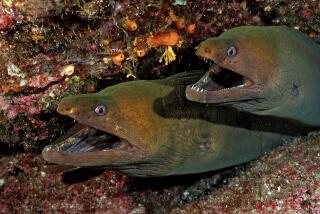Huge, Gentle Sea Manatees Falling Victim to Progress Along Florida’s Waterways
- Share via
MIAMI — A groggy volunteer crew of five gathered early last New Year’s Day and raced to where a 500-pound sea cow had been found with deep gashes from a boat propeller in its grayish-brown, leathery back.
But the West Indian manatee wasn’t injured in the congested Intracoastal Waterway, but rather in the Everglades. “It shows you they aren’t safe anywhere,” said Dr. Gregory Bossart, Miami Seaquarium veterinarian and pathologist.
Besides the unmistakable prop marks, the manatee had three fractured ribs and a punctured lung. The injuries caused a bubble to form inside the animal, leaving it floating helplessly.
The manatee--dubbed Marjory after Marjory Stoneman Douglas, a protector of the Everglades--has been recovering at the Seaquarium, one of two marine parks--the other is Sea World in Orlando--in Florida that are authorized to rescue the protected animal.
An estimated 1,200 of the prehistoric-looking creatures live in Florida, based on aerial surveys. The docile, plant-eating creatures, weighing more than 3,000 pounds and ranging from 8 to 14 feet long, are found from northern South America to as far north as Virginia.
They face a growing threat from Florida’s development boom.
A total of 133 manatee deaths were reported last year, including a record 43 from being hit by boats; there were 39 boat-related deaths in 1987. The 45 deaths so far this year exceeds the 1987 period. Through March, 15 deaths have been blamed on boats, and 23 carcasses were recovered in May alone.
“Our guess is that the numbers increased through the ‘60s and ‘70s as there was more protection, but in the ‘80s they’ve held about steady,” said Dr. Bruce Ackerman, a state marine mammal researcher. “If that’s the case, the fact that deaths are increasing is of considerable concern.”
Even if boat-related deaths were reduced, the manatee faces other obstacles such as a low reproductive rate and diminishing habitat, officials say.
“We’re not that optimistic. Their ability to recover from any kind of problem is limited, even if everything was perfect,” Ackerman said.
The rehabilitation of injured manatees is a painstaking process that takes months. There is also the question of what awaits them and babies born in captivity once they are returned to the wild.
“There’s no problem with breeding in the wild. The problem we have is habitat destruction,” said J. P. Garner, assistant manager of Homosassa Springs Park, where nine manatees are kept.
Manatees rely on sea grass beds for food and have begun to congregate around the warm-water discharges of power plants, where boat traffic is often heavy.
Patrick Rose, a marine mammal coordinator for the state Department of Natural Resources, said Florida is focusing efforts on tying manatee protection to county growth management plans. In addition, there has been an extensive campaign to increase public awareness about the creatures’ plight.
Singer-songwriter Jimmy Buffet gave a big boost to the manatee cause eight years ago when he became chairman of the Save the Manatee Club, which now boasts an international membership of about 22,000.
“They have absolutely no ability to be aggressive,” said Rose. “People identify with them as the ultimate victim.”
Months after being picked up, Marjory remains in guarded but stable condition in a Seaquarium tank, Bossart said. “She’s feeling a lot better and is able to dive better.”
More to Read
Sign up for Essential California
The most important California stories and recommendations in your inbox every morning.
You may occasionally receive promotional content from the Los Angeles Times.













